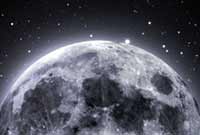

In 1685,
The moon is held in
orbit by
Earth's gravitational force. As a natural satellite, the Moon is
in
constant freefall about the Earth, falling towards the Earth's center
of
gravity. The reason that the moon doesn’t fall down to the
surface of the
Earth is because the curvature of the Earth makes the surface fall away
at the
same rate (Hecht 158). First proposed by
F = GmM/R²
where F is the force of gravity, G is the universal gravitational
constant, m
and M are the masses of the two bodies, and R is the distance between
the
centers of the two masses. For the
Earth-Moon system, the force of gravity between the two bodies is:
F = (6.67E-11
N·m²/kg²)(7.35E+22 kg)(5.98E+24 kg)/(3.84E+8m)²
F = 1.99E+20 N
To find the
acceleration due to
gravity of the Earth and Moon, you simply manipulate the equation F = ma
Since
F = m GM/R², g =
GM/R²
For the Earth with a mass of 5.98E+24 kg and a radius of
6.37E+6 m,
the acceleration due to gravity is:
g = (6.67E-11
N·m²/kg²)(5.98E+24 kg)/(6.37E+6 m)²
g
= 9.81 m/s²
For the Moon with a mass of 7.35E+22 kg and a radius of 1.74E+6
m, the
acceleration due to gravity is:
g = (6.67E-11
N·m²/kg²)(7.35E+22 kg)/ (1.74E+6 m)²
g
= 1.62 m/s²
The acceleration due to gravity of the Moon is 1.62 m/s², which is
only about a
sixth of the Earths g of 9.81 m/s². This difference in
gravitational
force between the two bodies is due to their difference in mass (Hecht
152).
